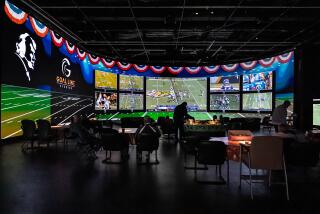Game Plan: Attempt to Bag a Super Bowl
Bob Payne has secrets. I don’t know what they are, or how many there may be, but they could be worth about $150 million.
Payne, you see, is the leader of this team that will send its best five “players” into competition today in what might be called The Final Five.
So much is at stake that he chooses not to divulge tactics or strategy.
Not that this Bob Payne is anything like Bobby Pain, the notorious leader of Indiana’s band of five. This fellow won’t be slamming telephones into their cradles or throwing chairs if all does not go his way.
A more reasoned approach is in order for Bob Payne and his team, because their “game” will last a mere 15 minutes and be “played” today before a rather stuffy gathering of 28 megamillionaires at the Hotel del Coronado.
These gentlemen, the owners of the 28 National Football League clubs, will be choosing the site of the 1991 Super Bowl from among San Diego, Anaheim, Tampa, Miami and Los Angeles. Such an event will have an economic impact of about $150 million on the host community.
Payne is a hotel developer who happens to be chairman of San Diego Super Bowl XXV Task Force. In this capacity, he approaches today’s occasion in the same way the most dedicated of coaches approach the Super Bowl game itself. No detail is too small with so much at stake.
“This is like five huge businesses competing for a contract,” Payne said Tuesday. “The Super Bowl business is very, very competitive, but we’re optimistic. We feel we’ve put together an excellent business plan.”
This business plan is essentially the game plan. Winning the chance to be host of this game will be worth much more than winning the game itself, though Payne and his team will be just a bit more obscure than such players as John Elway and Lawrence Taylor.
Payne’s “team” will include Mayor Maureen O’Connor, Dal Watkins, executive director of the Convention and Visitors Bureau; Leon Parma, president of La Jolla Capital; and Herb Klein, editor-in-chief of Copley Newspapers. These folks will have 15 minutes to make their sales pitch on behalf of San Diego. That’s 15 total, not each.
Obviously, this has to be a well-orchestrated (or choreographed) routine.
“We’re going to rehearse tonight,” Payne said. “We have to work on our timing and make adjustments in our strategy.”
San Diego has gotten to this point in much the same way that the National Basketball Assn. teams are advancing toward the finals. It has been a process of elimination. The San Diego Task Force has advanced through two presentations in New York and a third in Hawaii. This is a single-elimination “tournament” . . . with no losers’ bracket.
In keeping with the norm when it comes to professional football hereabouts, Payne’s strategy will be offensive. There’s no tussling among opponents, no give-and-take . . . and little “pregame” conversation.
“Each group will have its own strategies,” Payne said, “and no one will let on what those strategies might be.”
Al Saunders would give Tom Flores his offensive game plan before Bob Payne would detail exactly what his group will be presenting to the owners today.
San Diego does have some very obvious pluses, the weather likely being foremost. Of course, Yuma has good weather and it’s not a candidate for a Super Bowl. San Diego also has more than adequate hotel space, an expandable stadium, a sound foundation of community support, plentiful recreational activities, excellent restaurants and convenient practice facilities. And I’m sure I’m missing something.
All of these positives are already known to the NFL owners. These factors all contributed to the fact that the Super Bowl will be played here next January.
Obviously, Payne and his group have some tricks in their game plan. They will have other things to say. They will play more than what nature and the community have dealt them.
They will need everything they have in their book.
None of these finalists can be taken lightly, though I cannot see how the NFL can give such a plum to the Los Angeles Coliseum. That facility, in concert with Al Davis, has given the NFL quite a succession of migraines for the last few years.
The favorite, as I understand it, is Tampa. I don’t understand how such positioning is established, but it should be noted that San Diego was also an underdog when its task force went to Washington D.C. three years ago this month and secured the 1988 game.
If geography is a consideration, a Southern California venue might be logical for 1991. The game will be in Miami in 1989 and New Orleans in 1990, leaving the West Coast in line for a turn at the extravaganza.
It has been my suspicion all along that San Diego would not get a second Super Bowl until it had successfully staged its first. However, if that was of concern to the NFL, it would seem unlikely that San Diego would have been included among the five finalists for XXV . . . unless the NFL was simply trying to encourage the city during its final preparations for XXII.
Bob Payne thinks his team is nicely positioned. The work has been done. The only thing left to do is play the game. Indeed, for the City of San Diego, today’s game is bigger than the one to be played here next January.
More to Read
Go beyond the scoreboard
Get the latest on L.A.'s teams in the daily Sports Report newsletter.
You may occasionally receive promotional content from the Los Angeles Times.










